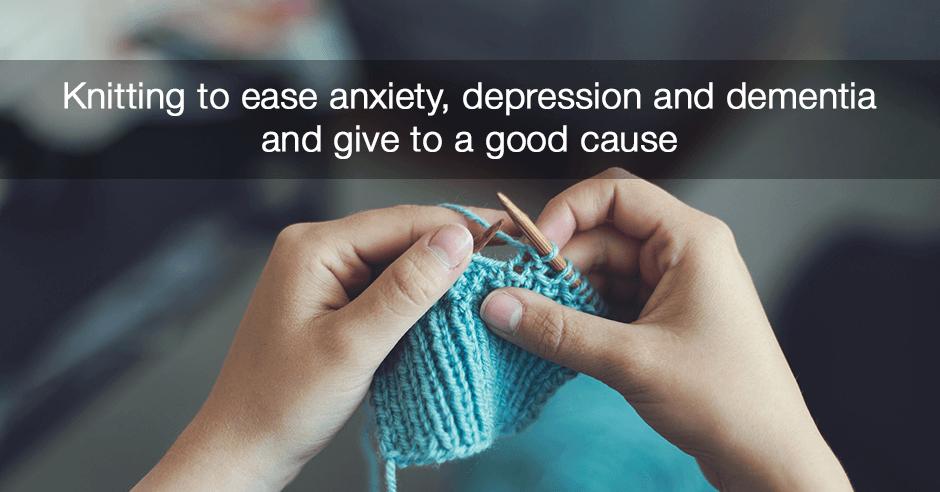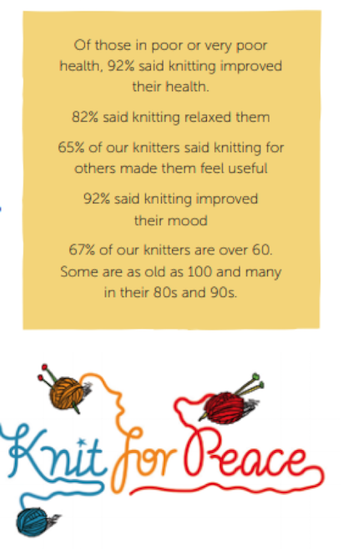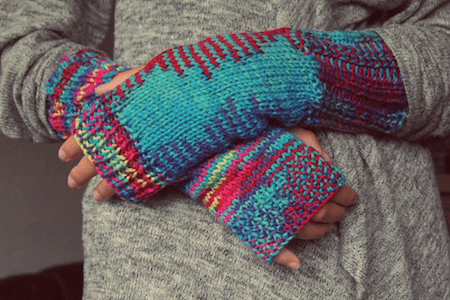
Knit for Peace, a UK based charity that “matches knitters with good causes” has published an extensive review of studies that reports the many physical and mental benefits of knitting, including easing anxiety and depression, benefiting those with dementia, helping with chronic pain, promoting a sense of community and improving sociability.
There is evidence-based research that shows that knitting does the following:
- Lowers blood pressure
- Reduces depression and anxiety
- Slows the onset of dementia
- Is as relaxing as yoga
- Distracts from chronic pain
- Provides an opportunity for creativity (at a time of reducing capacity)
- Increases sense of wellbeing
- Reduces loneliness and isolation
- Increases sense of usefulness and inclusion in society
Knitting for those in need is a volunteering activity that can carry on into extreme old age and can be undertaken by those whose sight, hearing and mobility are severely limited. It provides an activity that gives a sense of purpose. Knitting for charity makes people feel more useful and worthwhile. Self-worth is important post retirement, especially with physical decline.
They also surveyed their members about their knitting experiences. Here is some of the feedback they received:

You can read a summary of that report here and request the entire digital report here.
You’ll be able to read some of the heartwarming backstory of Knit for Peace in the above summary… how they “started as an income generation project for Hutu and Tutsi widows, victims of the Rwandan genocide and civil war” and grew to a similar project in India “bringing together Hindu and Muslim women in the slums of Delhi” and then “Knit for Peace groups were set up in Pakistan, Bangladesh, Nepal and Afghanistan.” … And then “when people in the UK heard about this project they asked if they could knit for the children of Afghanistan.” “Through word of mouth the idea spread, and we were soon receiving a positive tsunami of knitted goods.”
Positive feedback about knitting
I asked my community on Facebook if they knit and how it makes them feel.
Diane shared this: I noticed that knitting lowers my blood pressure but interesting to note that crochet lowers it even more. Maybe because the crochet is an easier pattern?
Catriona shared this: I did some knitting when I had horrible anxiety and depressive symptoms. Really helped keep me focused on the present, which made it hard to ruminate and worry while doing it. Like mindfulness. And you end up with a nice gift at the end of it.
Maria shared this: I don’t knit but I crochet a lot. Very therapeutic
Knitting is not for everyone
Knitting certainly isn’t for everyone. Bonnie shared this: Knitting did not lower my stress level at all. First of all, I don’t like to sit or stand still that much, it bothered my wrists and was not easy to pick up. I think I was more stressed from doing it. Mountain biking is my stress reliever!
Aminda shared this: Knitting leads me to want to poke out eyes with knitting needles lol. I’ll stick to my crossword puzzles. I’m super tired of being told I just have to try it and being treated like something is wrong with me because I find crafts the opposite of de-stress. I’m glad people love knitting… I’m just not one of them and I only got happier when I stopped trying to fit onto the mold.
If knitting isn’t for you don’t worry about it, rather find something that you love to do.
Knitting is for kids too
I was very fortunate to have my granny teach me when I was about 8 years old. We had such fun time together, making scarves, gloves, baby clothes for my dolls and then my baby sister and eventually jerseys/jumpers for myself. It was a very special bonding time and it’s a skill I’ll always have. My granny was fearful of storms and I’d like to think knitting helped ease some of her anxieties.
I feel we should be encouraging kids to knit too. Many anxious kids could benefit from anxiety relief and contribute to a worthy cause by giving away their finished items.
Christina shared this on the Huffington Post blog: I’m an elementary teacher and I have a knitting group at lunch on Wednesday’s! The kids love it! It promotes patience, concentration and perseverance! I have about 25 students ages 10-12, both girls and boys!

Some of the research
In this Norwegian study, Knitters in a Day Center: The Significance of Social Participation for People With Mild to Moderate Dementia, the main activity of elderly women with mild dementia was knitting. It was found that
the social activity of knitting facilitated conversations about different topics, required various forms of memory and problem solving, and involved different participant statuses. Being part of the knitting group appeared to help the participants maintain their skills and facilitated sociability.
In this study, Managing anxiety in eating disorders with knitting, 38 women with anorexia reported these benefits of knitting:
- it lessened the intensity of their fears and thoughts and cleared their minds of eating disorder preoccupations (74%)
- it had a calming and therapeuticeffect (74%)
- it provided satisfaction, pride and a sense of accomplishment (53%)
Where do you start if you don’t know how to knit?
If you didn’t learn to knit as a kid and want to learn now or possibly want your child or grandchild to learn, knitting is inexpensive and easily learned. Here are some resources for you:
- The Complete Beginner’s Guide to Knitting (DVD). “Beautiful and clear demonstrations can get you started knitting in just 30 minutes.” You’ll learn all the basic stitches, get a booklet with scarf patterns and other bonus goodies.
- A good starter yarn such as Lion Brand’s Wool Ease is recommended. Avoid dark colors when you are first learning to knit.
- Wooden needles like Brittany 10-inch long Single Point Birch Knitting Needles are also suggested, US Size 10, 10.5 or 11. They say to avoid the more slippery metal needles (although I used these and they were fine), and the “grippy” plastics. (All these links are my Amazon affiliate links)
Knit as part of a group and give to someone in need
Whether or not you’re new to knitting, consider getting a knitting group together for that wonderful community aspect and once you’ve knitted enough goodies for family and friends, start to send knitted goods to a charity such as Knit for Peace or take them to a local shelter.
If you work in a nursing home or long-term care facility, in a school or after-school program, or are part of a church group, I encourage you to get a group knitting program together. Or you could even get together with friends and start knitting.
Notice the calmness you feel when you knit and the joy of giving your finished product to someone in need.
We’d love to hear if you knit and when you learned? And how do you feel when you knit? Are you part of a community knitting group and who do you knit for?
I love this. I learned to knit as an adult. I am about to found my third knitting/crochet/needlework group. Each time I start a group we usually wind up adding in projects for charity. For example one group produced 100 hats for the homeless. I find both knitting and crochet to be very relaxing and enjoyable. I especially love doing handicrafts in a group with other like-minded people.
Mira
This is wonderful – thanks for sharing! Love the hats for the homeless and glad to hear it’s relaxing and enjoyable!
Was it easy to learn to knit as an adult and do you have any advice for adults who may want to learn?
It was easy to learn how to knit as an adult. Learning to keep my tension the same took a little more practice. My first pair of mittens I had to make three in order to get two of the correct size LOL
My advice for those who want to learn is to find a knitting group near you. People in these groups are always delighted to help others learn how to knit or crochet. If you’re not sure how to find a group visit your local yarn shop and ask them, they usually know where folks are meeting or they may have their own group going.